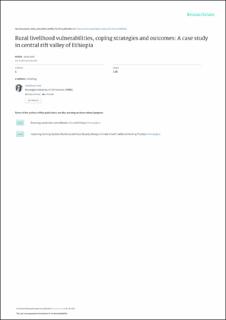| dc.description.abstract | Extensively vulnerable mixed rain-fed farming system is the underlying mainstay of livelihoods of farmers in the central Rift Valley of Ethiopia. This study aimed to assess determinants of farmers’ livelihood vulnerabilities to shocks, their coping strategies and outcomes. Cross-sectional data were collected from farmers, agricultural experts, and other development workers through formal and informal focus group discussions, key informant interviews and complemented by field observations. Results showed that natural, institutional, and physical factors are the overriding determinants triggering rural livelihood vulnerabilities to frequent food shocks. Particularly, unpredictable rainfall timing and severity, and ineffective early warning system had practically escalated livelihood vulnerabilities to food shocks. Farmers varied in their assets and socioeconomic capabilities, including wealth status, livestock and poultry holding size, farm size and its soil fertility status, participation in local social networks, and financial capital and access to credit facilities. Farmers also varied in their vulnerability to encountering food shocks and capability to coping. Strategies practiced by households to increase livelihood resilience to rainfall variability include selection of appropriate crop variety, selection of appropriate calendar for planting, intercropping, crop rotation and indigenous in situ rainwater harvesting. Sharing grains among households themselves, selling small ruminants, engaging in off-farm activities and migration were key ameliorative strategies to handle small-scale and temporary food shocks. While, institutional interventions with Food Aid and Safety Net programs were commonly used as the underlying coping strategies for severe and large-scale food shocks. The livelihood outcomes were characterized by continued endeavors to avert the inappropriate land management system, to adapt to the recurrent drought and dry spells, and to improve the inadequate early warnings condition for seasonal agro-meteorology. Therefore, authors suggest concerted efforts of stakeholder institutions and local communities to improve the livelihood outcomes that should enhance household capabilities, activities, assets and accesses; reduce vulnerabilities to shocks; and ensure sustainable agricultural production system in central Rift Valley of Ethiopia. | en_US |

